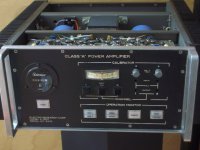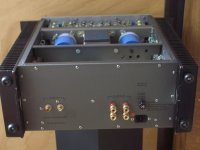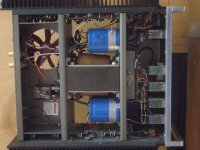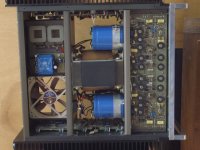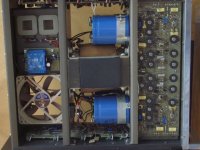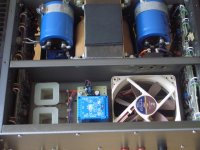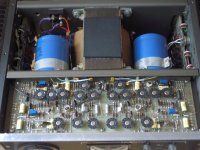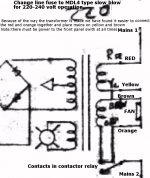Last week in my workshop : the "legendary" Iverson Power Amplifier.
Pictures of front and backside. The original time counter has been replaced
by one made in Germany and has already counted more than 8000 hours.
Speaker posts and RCA sockets are not original.
Pictures of front and backside. The original time counter has been replaced
by one made in Germany and has already counted more than 8000 hours.
Speaker posts and RCA sockets are not original.
Attachments
Last edited:
More pictures
Top and bottom cover can be removed for full access to the self supporting chassis.
The main caps are not original. Somebody added a supply and regulator for the fan.
Mains transformer has a primitive EI core. Driver board in front is separated from the
current amps on the heatsinks. The big caps seem to be assigned l and r, but share
the same rectifier.
Top and bottom cover can be removed for full access to the self supporting chassis.
The main caps are not original. Somebody added a supply and regulator for the fan.
Mains transformer has a primitive EI core. Driver board in front is separated from the
current amps on the heatsinks. The big caps seem to be assigned l and r, but share
the same rectifier.
Attachments
schematic with mods
Here the diagram of a single channel with changes and modifications made by
Russ Sherwood of EKSC Eagle, eagle audio .
The amplifier in question apparently has these modifications.
Here the diagram of a single channel with changes and modifications made by
Russ Sherwood of EKSC Eagle, eagle audio .
The amplifier in question apparently has these modifications.
Attachments
That is one industrial looking piece of gear
That's one reason that I really, really wanted one back in the day.
Not sure why somebody asked to re-open this thread, but in the meantime
we can read a snippet from Popular Electronics, September 1978, page 22 :
"The show's most imposing amplifier may have been the Electro Research
A75V1, 85 pounds of massively constructed class-A design on the hoof, offering
75 watts per channel into 8 ohms and 300(!) watts per channel into 1,25 ohms."
(CES 1978 in Chicago)
we can read a snippet from Popular Electronics, September 1978, page 22 :
"The show's most imposing amplifier may have been the Electro Research
A75V1, 85 pounds of massively constructed class-A design on the hoof, offering
75 watts per channel into 8 ohms and 300(!) watts per channel into 1,25 ohms."
(CES 1978 in Chicago)
Hi All,
Recently acquired an a75 and want to know who I can trust tech wise to have it checked out.
I’m in Burbank CA.
The amp sounds great. But there may be a little hash in the 2kHz-10kHz range.
I’m hoping someone out there can recommend a tech that will treat this amp like the treasure it is.
Please be in touch!
Thanks!
Recently acquired an a75 and want to know who I can trust tech wise to have it checked out.
I’m in Burbank CA.
The amp sounds great. But there may be a little hash in the 2kHz-10kHz range.
I’m hoping someone out there can recommend a tech that will treat this amp like the treasure it is.
Please be in touch!
Thanks!
In the Swedish magazine "radio & television", April 1978, Svein-Erik Børja and Bjørn Scheele
describe on p. 19 ff a "Dream System", where the A-75 acts as a sub-woofer amp :
"It can seem a bit challenging to use a super construction like John Iverson's Electra Research
only to drive a sub-woofer system with ! But due to the fact that the Dream System's loudspeaker
<Beveridge Cylindrical Sound System> has built-in amplification, the Electro Research product
has nothing to do but feed the "sub-bass".
On the other hand, it can be assumed to do this better than any other amplifier. It seems that the
majority of reviewers agree that when connected to the A-75 it contributes almost an entire octave
of extra bass reproduction. How it comes about is not investigated but a bit of a mystery that is
pondered over. One theory is that the ability has something to do with the high current capacity of
ER.
With the introduction of Electro Research A-75, we complete the chain of Class A drive within the
Dream System. The technical performance data are impressive: Power bandwidth (half-) direct current
to 400 kHz, slew rate 105 V / μs, stability within 2.5 ohms, s/n 100 dB, harmonic and intermodulation
distortion lower than 0, I % from dc limit up to 50 kHz. If you use the amplifier as it is supposed to be
used, i.e. as a full-range stage, you experience moments of actually almost terrifying realism, as if the
entire technology is collapsing and the music - this invisible medium - is taking shape right in front of
the listener.
The entire impression of the sound image becomes coherent, both in detail and as a whole. The
spaciousness as a dimension is of a different dignity than that of other amplifiers, with an unimagined
depth and a physically tangible focus of every element of the program's instrumentation and parts. You
get a perfect tonal balance, where, for example, the treble never feels intrusive. Inserted into the Dream
facility, the A-75 provides some qualities that no other known amplifier possesses today. Actually, its
presence means a kind of "overkill", but once you get to know it, it becomes too noticeable to be without
it in the future...
Weaknesses: The fan built into the chassis is unfortunately not silent but makes noise in a way that is
heard over silent parts. Unless the A-75 is built into some kind of insulating enclosure (cabinet), this
cannot be avoided."
(Corrected Google translation)
describe on p. 19 ff a "Dream System", where the A-75 acts as a sub-woofer amp :
"It can seem a bit challenging to use a super construction like John Iverson's Electra Research
only to drive a sub-woofer system with ! But due to the fact that the Dream System's loudspeaker
<Beveridge Cylindrical Sound System> has built-in amplification, the Electro Research product
has nothing to do but feed the "sub-bass".
On the other hand, it can be assumed to do this better than any other amplifier. It seems that the
majority of reviewers agree that when connected to the A-75 it contributes almost an entire octave
of extra bass reproduction. How it comes about is not investigated but a bit of a mystery that is
pondered over. One theory is that the ability has something to do with the high current capacity of
ER.
With the introduction of Electro Research A-75, we complete the chain of Class A drive within the
Dream System. The technical performance data are impressive: Power bandwidth (half-) direct current
to 400 kHz, slew rate 105 V / μs, stability within 2.5 ohms, s/n 100 dB, harmonic and intermodulation
distortion lower than 0, I % from dc limit up to 50 kHz. If you use the amplifier as it is supposed to be
used, i.e. as a full-range stage, you experience moments of actually almost terrifying realism, as if the
entire technology is collapsing and the music - this invisible medium - is taking shape right in front of
the listener.
The entire impression of the sound image becomes coherent, both in detail and as a whole. The
spaciousness as a dimension is of a different dignity than that of other amplifiers, with an unimagined
depth and a physically tangible focus of every element of the program's instrumentation and parts. You
get a perfect tonal balance, where, for example, the treble never feels intrusive. Inserted into the Dream
facility, the A-75 provides some qualities that no other known amplifier possesses today. Actually, its
presence means a kind of "overkill", but once you get to know it, it becomes too noticeable to be without
it in the future...
Weaknesses: The fan built into the chassis is unfortunately not silent but makes noise in a way that is
heard over silent parts. Unless the A-75 is built into some kind of insulating enclosure (cabinet), this
cannot be avoided."
(Corrected Google translation)
You wrote "the amp sounds great. But there may be a little hash in the 2kHz-10kHz range".
In other words the amp is fine. Somebody in the area can probably do some measurements
to confirm this. Sorry my workshop is on a different continent.
Re the schematic in post 4 : can somebody see how the relay works ? Bad copy and messy
drawing - if this is sort of speaker relay it may need some claning.
In other words the amp is fine. Somebody in the area can probably do some measurements
to confirm this. Sorry my workshop is on a different continent.
Re the schematic in post 4 : can somebody see how the relay works ? Bad copy and messy
drawing - if this is sort of speaker relay it may need some claning.
Love it. Reminds me of 1950s transmitter equipment, especially the switches and counter.That is one industrial looking piece of gear
- Home
- Amplifiers
- Solid State
- Electro Research Corp. Model A75 Iverson power amplifier
